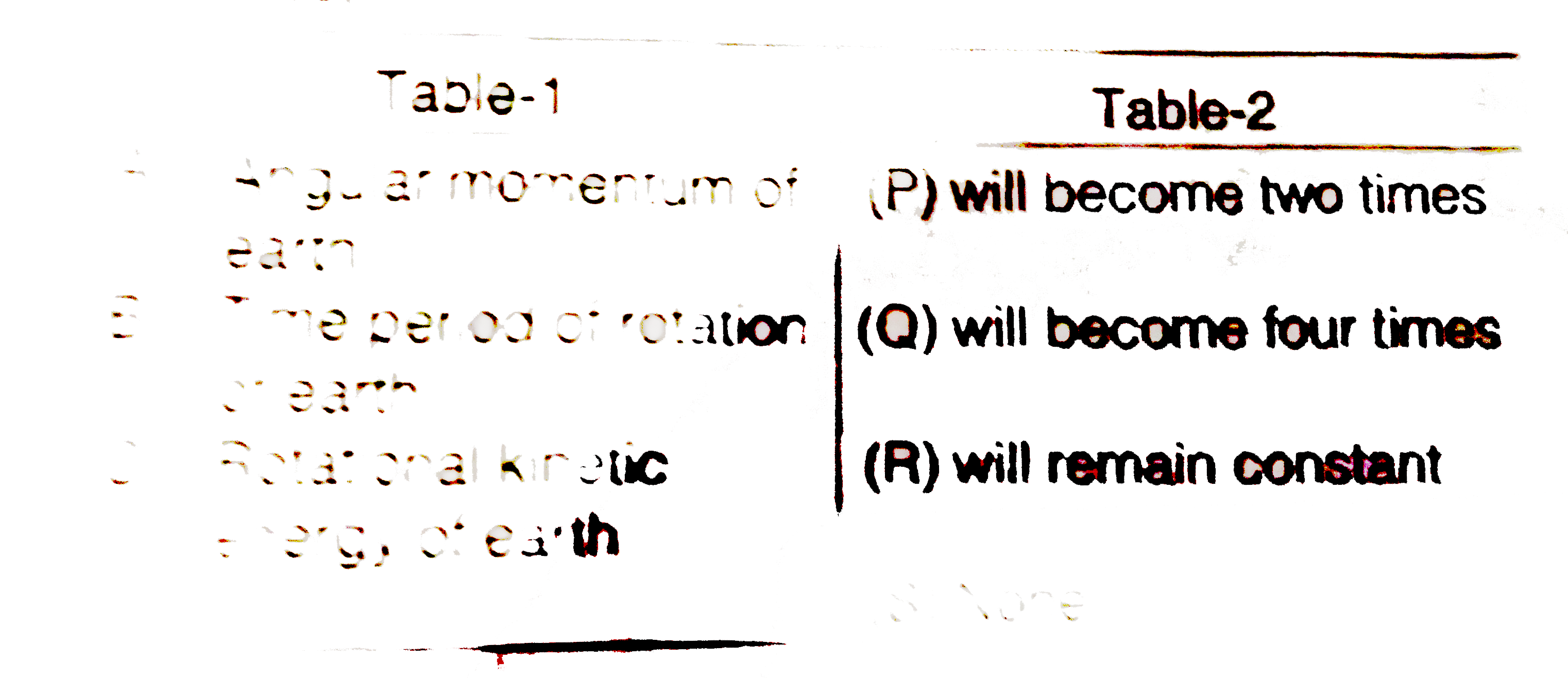If the radius of the earth contracts to half of its present value without change in its mass, what will be the new duration of the day?
To solve the problem of determining the new duration of the day if the radius of the Earth contracts to half of its present value without a change in its mass, we can follow these steps:
1. Understand the Concept of Angular Momentum:
The angular momentum (L) of a rotating body is given by the formula:
L=Iω
where I is the moment of inertia and ω is the angular velocity.
2. Calculate the Initial Angular Momentum:
The moment of inertia I for a solid sphere (like Earth) is given by:
I=25mr2
Therefore, the initial angular momentum L1 can be expressed as:
L1=Iω=25mr2ω
3. Calculate the New Angular Momentum:
When the radius contracts to half, the new radius becomes r′=r2. The new moment of inertia I′ will be:
I′=25m(r2)2=25mr24=110mr2
Thus, the new angular momentum L2 is:
L2=I′ω′=110mr2ω′
4. Apply Conservation of Angular Momentum:
Since there are no external torques acting on the Earth, angular momentum is conserved:
L1=L2
Substituting the expressions we derived:
25mr2ω=110mr2ω′
5. Simplify the Equation:
Cancel m and r2 from both sides:
25ω=110ω′
Rearranging gives:
ω′=4ω
6. Relate Angular Velocity to Time Period:
The angular velocity ω is related to the time period T by:
ω=2πT
Therefore, if ω′=4ω, we can write:
2πT′=4⋅2πT
This implies:
T′=T4
7. Calculate the New Duration of the Day:
The current duration of the day T is 24 hours. Thus:
T′=24 hours4=6 hours
Final Answer:
Hence, the new duration of the day is 6 hours.
The angular momentum (L) of a rotating body is given by the formula:
L=Iω
where I is the moment of inertia and ω is the angular velocity.
The moment of inertia I for a solid sphere (like Earth) is given by:
I=25mr2
Therefore, the initial angular momentum L1 can be expressed as:
L1=Iω=25mr2ω
When the radius contracts to half, the new radius becomes r′=r2. The new moment of inertia I′ will be:
I′=25m(r2)2=25mr24=110mr2
Thus, the new angular momentum L2 is:
L2=I′ω′=110mr2ω′
Since there are no external torques acting on the Earth, angular momentum is conserved:
L1=L2
Substituting the expressions we derived:
25mr2ω=110mr2ω′
Cancel m and r2 from both sides:
25ω=110ω′
Rearranging gives:
ω′=4ω
The angular velocity ω is related to the time period T by:
ω=2πT
Therefore, if ω′=4ω, we can write:
2πT′=4⋅2πT
This implies:
T′=T4
The current duration of the day T is 24 hours. Thus:
T′=24 hours4=6 hours
Hence, the new duration of the day is 6 hours.
Topper's Solved these Questions
- GRAVITATIONBOOK - DC PANDEY ENGLISHCHAPTER - GRAVITATIONEXERCISE - Level 2 Single Correct
22 Videos
- GRAVITATIONBOOK - DC PANDEY ENGLISHCHAPTER - GRAVITATIONEXERCISE - Level 2 More Than One Correct
10 Videos
- GRAVITATIONBOOK - DC PANDEY ENGLISHCHAPTER - GRAVITATIONEXERCISE - Level 1 Single Correct
27 Videos
- GENERAL PHYSICSBOOK - DC PANDEY ENGLISHCHAPTER - GENERAL PHYSICSEXERCISE - INTEGER_TYPE
2 Videos
- KINEMATICSBOOK - DC PANDEY ENGLISHCHAPTER - KINEMATICSEXERCISE - INTEGER_TYPE
10 Videos
Similar Questions
If radius of the earth contracts to half of its present value without change in its mass, what will be the new duration of the day?
View SolutionIf radius of the earth contracts to half of its present value without change in its mass, what will be the new duration of the day?
View SolutionIf the earth, were suddenly contracted to (l/n)th of its present radius without change in its mass, then what will be the effect on the duration of the day.
View SolutionIf earth suddenly contracts to half of its present radius keeping its mass constant what would be the length of the day?
View SolutionIf radius of earth is reduced to half without changing its mass,

View SolutionIf the radius of earth contracts 1/n of its present day value, the length of the day will be approximately
View SolutionIf the radius of the earth becomes half of its present value (mass remaining the same ), the new length of the day would be
View SolutionAssertion : If radius of earth suddenly shrinks to half its present without changing its mass value, then the period of an earth's satellite will not change
Reason : Time period of a satellite does not upon the mass of earth.
View SolutionIf earth radius reduces to half of its present value then the time period of rotation will become:
View SolutionIf the radius of the earth suddenly decreases to 80% of its present value, the mass of the earth remaining the same, the value of the acceleration due to gravity will
View Solution
